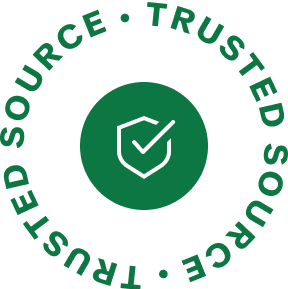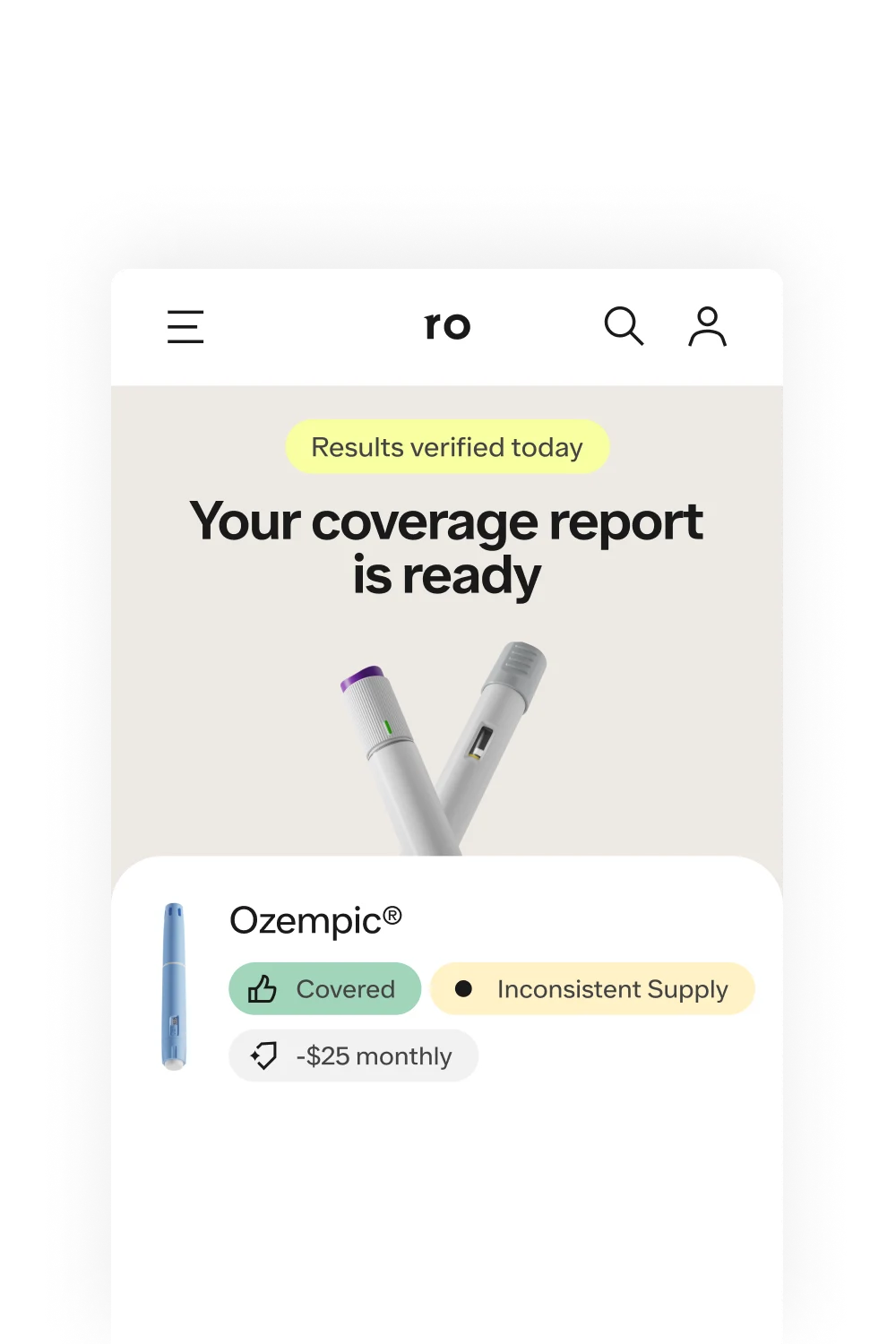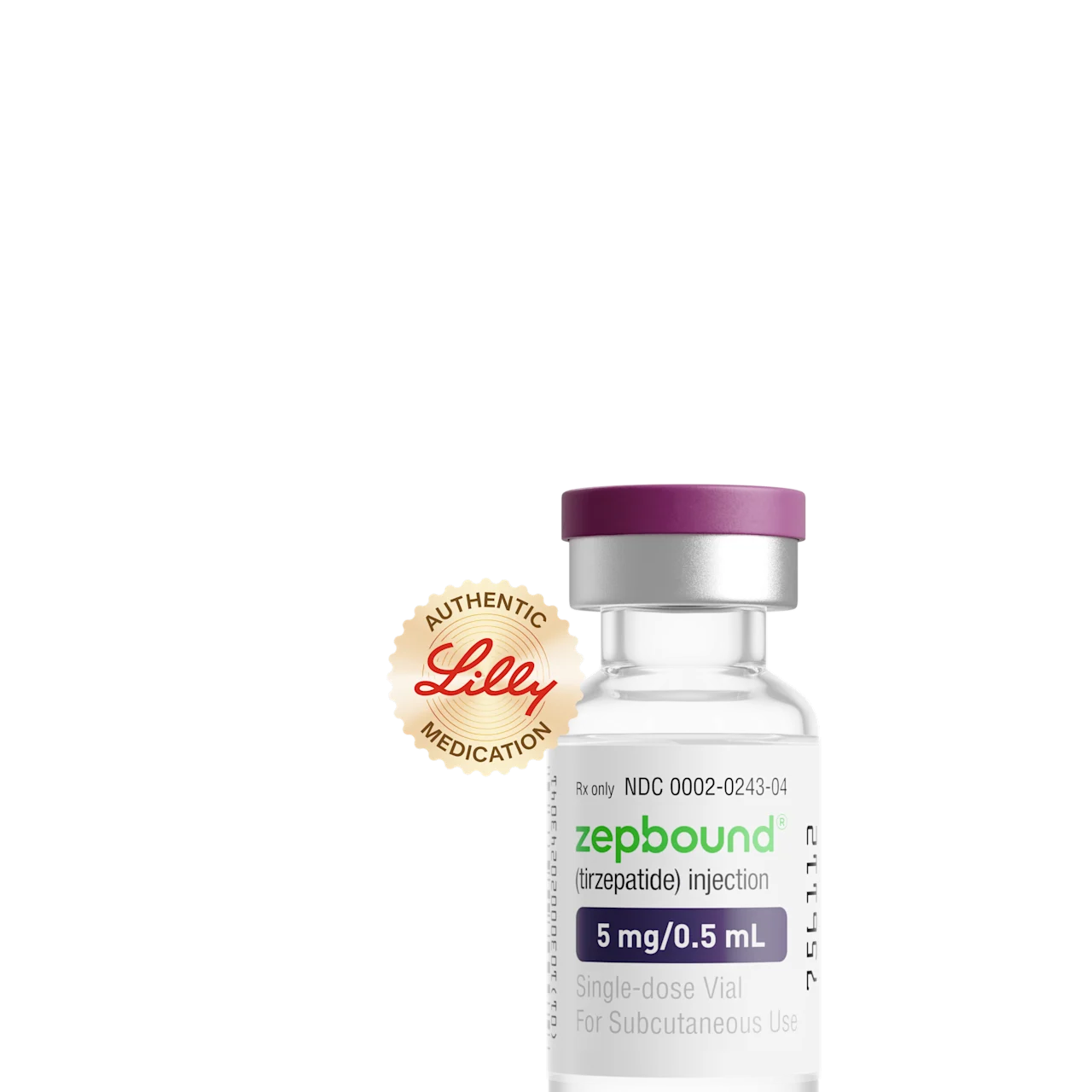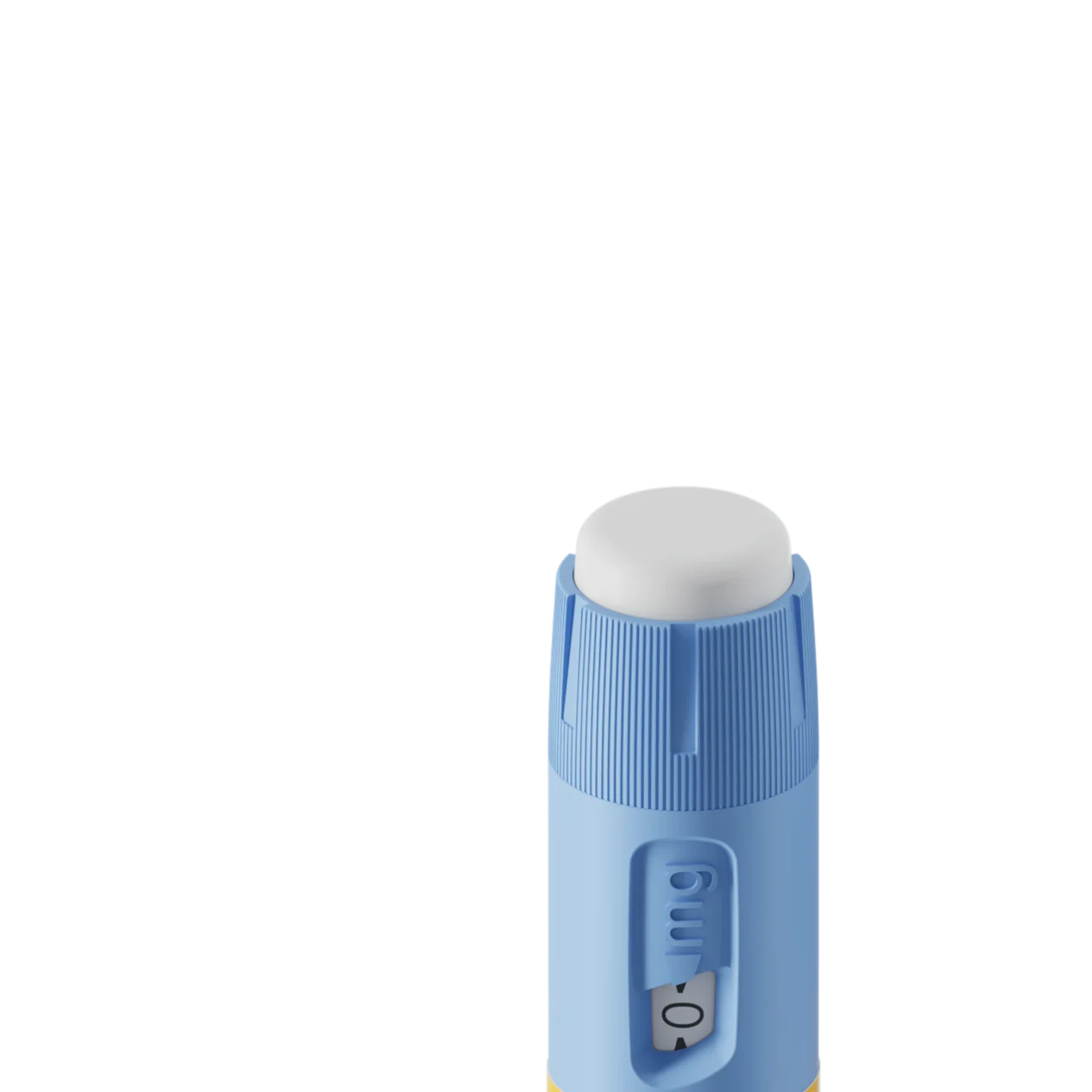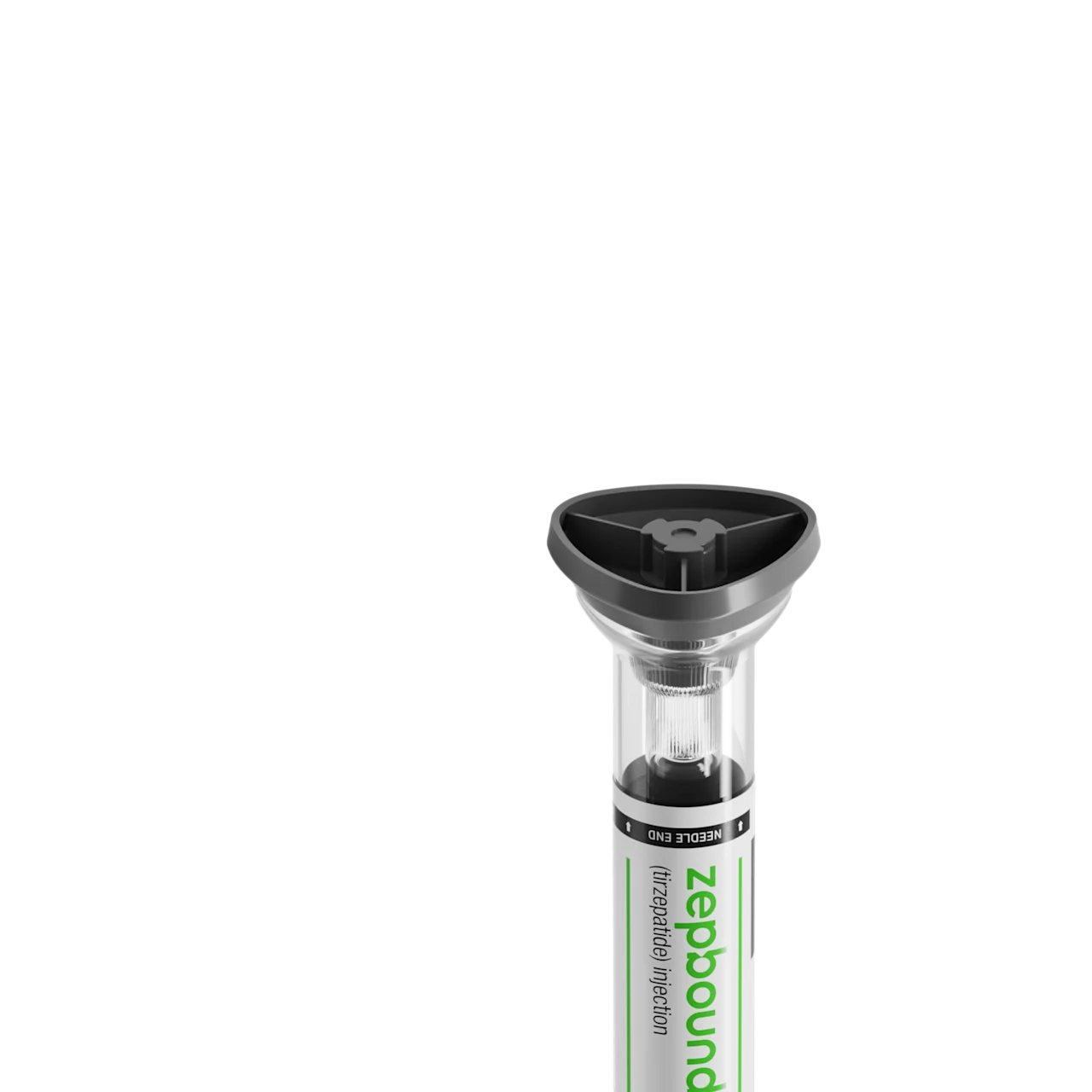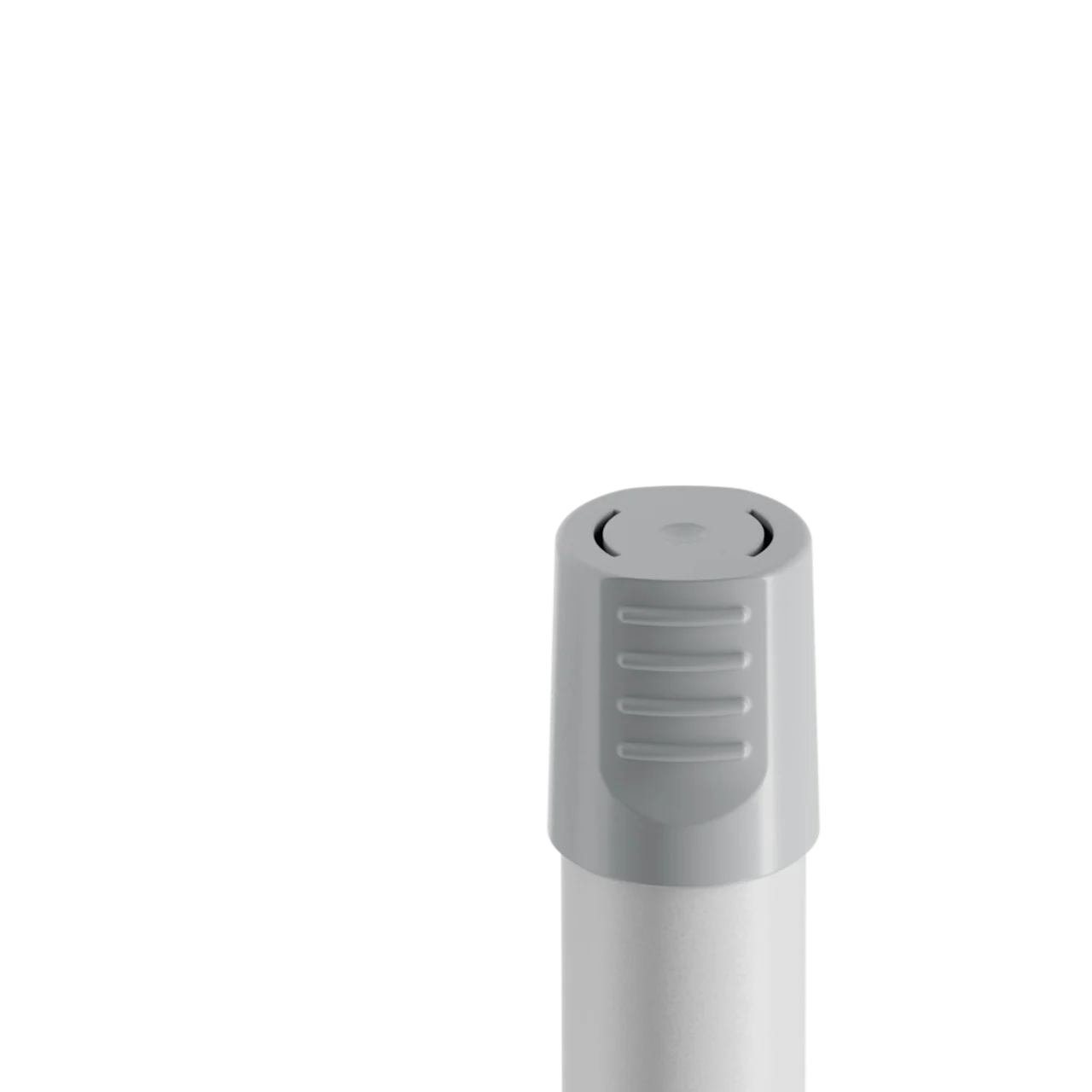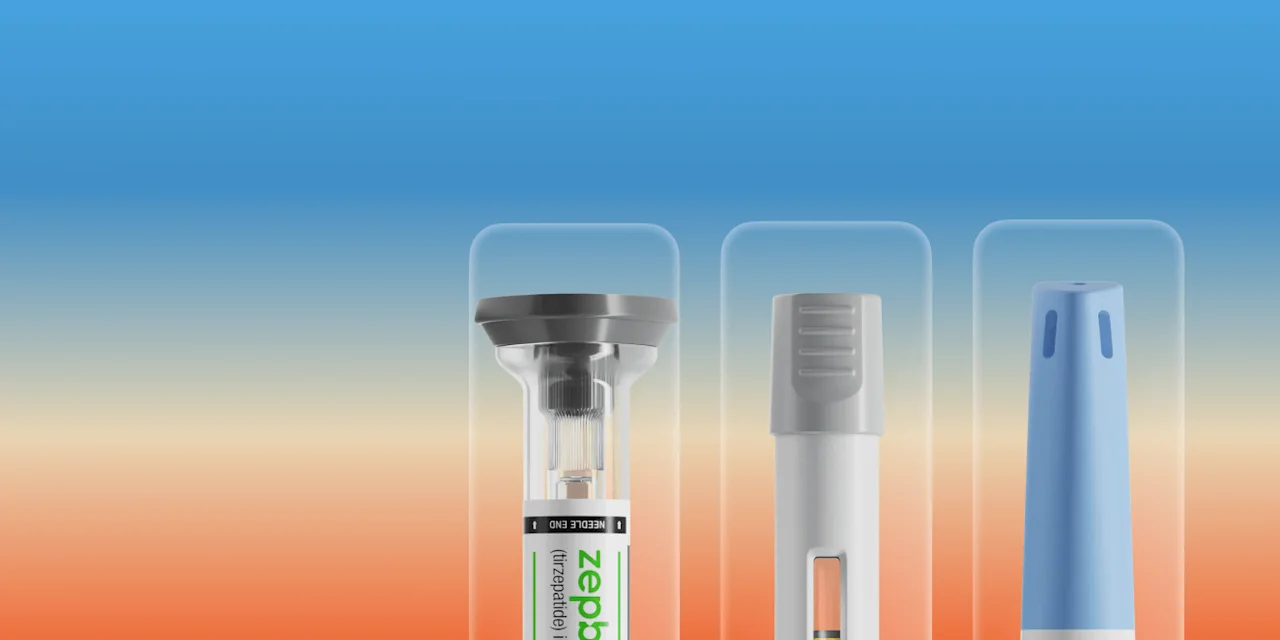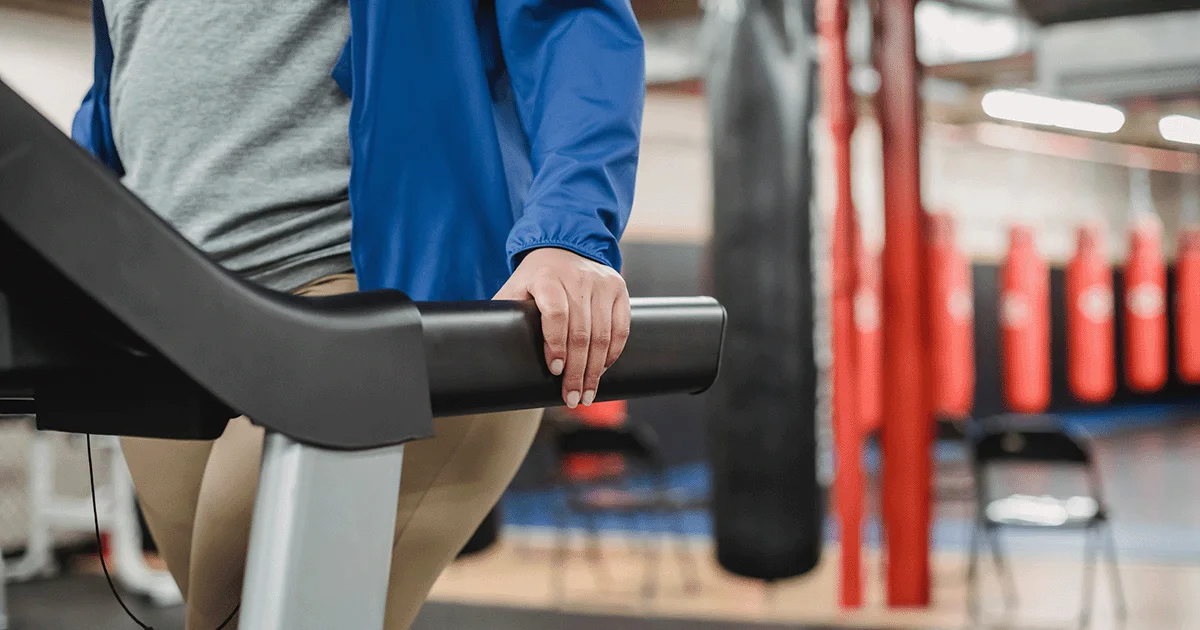Key takeaways
There’s no official semaglutide diet, but experts generally recommend eating a reduced-calorie, nutrient-dense diet.
Try to include a balance of lean proteins, healthy fats, fruits, vegetables, and whole grains.
It’s also smart to avoid or limit refined carbohydrates and foods high in sodium, saturated fats, and sugar, since these can worsen side effects and derail progress.
Here's what we'll cover
Here's what we'll cover
Here's what we'll cover
Key takeaways
There’s no official semaglutide diet, but experts generally recommend eating a reduced-calorie, nutrient-dense diet.
Try to include a balance of lean proteins, healthy fats, fruits, vegetables, and whole grains.
It’s also smart to avoid or limit refined carbohydrates and foods high in sodium, saturated fats, and sugar, since these can worsen side effects and derail progress.
There isn’t a single specialized or recommended semaglutide diet plan. However, all three semaglutide drugs — Ozempic, Wegovy, and Rybelsus — are intended to be used alongside a reduced-calorie diet and increased physical activity.
Depending on your health status and goals, that may mean eating up to 500–750 fewer calories per day. For many adults, this comes out to about 1,200–1,800 total calories daily. But you don’t want to cut calories too aggressively either, as eating too little can increase side effects and slow metabolism.
Ahead, we break down everything you need to know about making a semaglutide diet plan, including the foods to eat and those to avoid.
What to eat on semaglutide
Whether you’re taking semaglutide for weight loss, type 2 diabetes, heart health, or kidney health, the ideal diet should emphasize nutrient-dense foods. Think: foods that promote satiety, sustain blood sugar levels, support energy, and maintain basic bodily functions (e.g. digestion, immunity).
Here’s a breakdown of the key foods that should fill your plate on a semaglutide diet:
Lean proteins: Around 15%–25% of your calories should come from lean proteins, such as turkey, tofu, lentils, beans, and chicken.
Whole carbohydrates: Around 40%–65% of your calories should come from whole carbs, such as fruits, vegetables, legumes, and whole grains.
Healthy fats: Around 20%–35% of your calories should come from healthy fats, such as avocados, nuts, seeds, olive oil, and fatty fish.
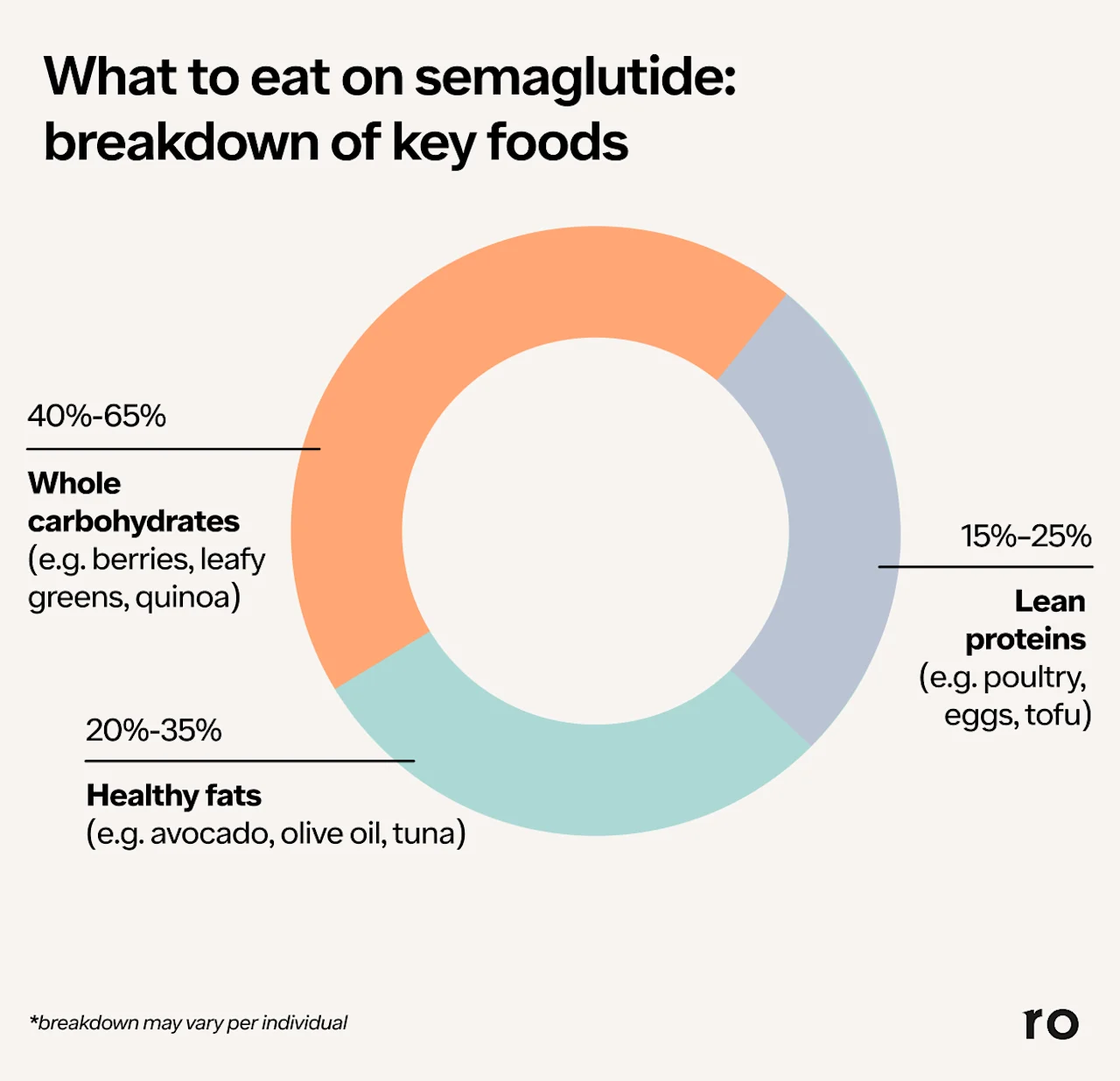
Fruits and vegetables
What to eat:
Berries (e.g. strawberries, blueberries)
Bananas
Apples
Pears
Citrus
Grapes
Bell peppers
Broccoli
Tomatoes
Peas
Carrots
Squashes
Leafy greens (e.g. spinach, kale)
Rx weight loss with Ro
Get access to prescription weight loss medication online
How much to eat: Most adults should aim for 1.5–2 cups of fruit and 2–3 cups of vegetables per day, according to the US Department of Agriculture (USDA) Dietary Guidelines for Americans.
Along with whole grains, fruits and vegetables can make up the bulk of your carbohydrate intake. Most adults typically get about 45%–65% of their total daily calories from carbohydrates — a general guideline that also works well for a semaglutide diet.
Why you should eat: “Fruits and vegetables are packed with vitamins, minerals, antioxidants, phytonutrients, and fiber that we need to function and thrive,” says Lauren Harris-Pincus, MS, RDN, Ro Dietitian Advisor and cookbook author.
They’re also naturally low in calories. So you can eat more of them without worrying as much about your calorie deficit when you’re trying to lose weight.
The fiber content of fruits and vegetables is particularly helpful for weight loss, heart health, and blood sugar control.
For weight loss:Fiber helps increase satiety by slowing digestion, adding bulk to meals, and stimulating fullness-promoting gut hormones. These effects help you stay fuller for longer and can naturally reduce appetite and overall calorie intake, helping to support weight-loss goals.
For heart health: Soluble fiber binds to cholesterol and bile acids in the digestive tract, reducing their absorption and helping lower LDL (“bad”) cholesterol — a major risk factor for heart disease. Good sources of soluble fiber include oats, beans, lentils, apples, pears, citrus fruits, carrots, and barley.
For blood sugar control: Fiber slows the digestion and absorption of carbohydrates, which helps prevent sharp blood sugar spikes and supports better management of type 2 diabetes.
Fresh and frozen fruits are your best bet because they generally contain the highest nutrient content.
If you choose canned fruit, avoid varieties packed in syrup since the added sugar can work against your health goals. For canned vegetables, look for low-sodium options or rinse them before using to wash off excess salt.
FYI, you don’t need to avoid fruit while managing diabetes. Even though fruit contains natural sugars, its fiber and nutrient content help slow digestion and prevent sharp blood sugar spikes — and regular fruit intake is actually linked to better glycemic (or blood sugar) control in people with diabetes.
For weight loss goals, it may also help to prioritize non-starchy vegetables (i.e. those that are lower in carbs), such as leafy greens, broccoli, Brussels sprouts, and eggplant, when possible.
Whole grains
What to eat:
Quinoa
Brown rice
Oats
Whole-wheat bread, cereal, or pasta
Barley
Rye
How much to eat: In general, adults should aim for 3–7 ounces of whole grains per day, as recommended by the USDA. A helpful rule of thumb is to make at least half of the grains you eat whole grains.
Why you should eat: Contrary to popular belief, carbohydrates aren’t off-limits for weight loss, heart health, or diabetes management. It comes down to the type of carbohydrate source you choose: refined vs. whole. Whole grains are the way to go, according to Pincus.
Compared to refined grains, whole grains contain more essential nutrients that support the effects of semaglutide. This includes fiber, which increases satiety, slows digestion, and helps maintain blood cholesterol.
The additional fiber in whole grains also helps balance blood sugar, supporting more stable energy levels even as you eat fewer calories, Pincus says.
Lean proteins
What to eat:
Skinless chicken
Turkey
Tofu
Seafood (e.g. tuna, shrimp, salmon)
Low-fat dairy products (e.g. cottage cheese, Greek yogurt)
Legumes (e.g. beans, lentils)
Nuts and seeds (e.g. chia seeds, cashews, almonds)
How much to eat: Protein needs vary based on body weight, age, and activity level. In general, adults aiming for weight loss (and engaging in regular exercise) typically need about 0.8–1.2 grams of protein per kilogram of body weight per day.
“It’s ideal to spread protein intake throughout the day with a minimum of 20 grams per meal, ideally 25–30 grams, plus an extra 5–15 grams per snack,” Pincus says.
Find your recommended protein intake
Calculate your recommended daily protein needs for weight loss, maintaining weight, or building muscle, based on your current weight and activity level.
Recommended protein intake
0 – 0
Grams/Day
0 – 0
Grams/Meal
This calculator provides general estimates and should not replace professional medical advice. Always consult a healthcare provider or registered dietitian before making significant changes to your diet or nutrition plan.
Why you should eat: Prioritizing sources of lean protein is critical while taking semaglutide, Pincus says. (By the way, “lean” means the protein is naturally low in calories and saturated fat.)
Consuming adequate protein can help minimize muscle loss, which often accompanies weight loss. Plus, dietary protein can support muscle growth when combined with regular exercise (which, friendly reminder, is recommended when taking semaglutide).
Maintaining or building muscle mass keeps your basal metabolic rate up, allowing you to burn more calories at rest and experience more weight loss.
Lean proteins also take longer to digest, which can help prevent quick spikes in blood sugar levels:
In the short term, the rapid rise and fall of blood sugar levels can increase hunger and cravings, which may lead to overeating and contribute to weight gain.
In the long term, repeated blood sugar spikes increase the risk of type 2 diabetes — and for those who already have diabetes, they can raise the risk of heart disease.
Healthy fats
What to eat:
Olive oil
Nuts and seeds
Fatty fish (e.g. sardines, tuna, salmon)
How much to eat: Fats should make up 20%–35% of your daily calories, which comes out to roughly 30–70 grams of total fat per day for most adults, depending on calorie needs.
Why you should eat: Like carbohydrates, fats are an essential part of any healthy eating plan, including a semaglutide diet.
It’s best to focus on unsaturated (“good”) fats, which provide essential fatty acids (think: omega-3s), Pincus says. These fatty acids are needed for sustaining energy, regulating hormones, supporting brain function, and helping the absorption of fat-soluble vitamins from other foods in your diet.
Unsaturated fats can also be beneficial for the heart; they’ve been shown to lower LDL (“bad”) cholesterol. This can help reduce the risk of heart disease and complement the cardiovascular benefits of semaglutide.
Foods to avoid eating on semaglutide
While every food can be part of a balanced diet, it can be worth limiting your intake of certain foods on semaglutide. Think: foods high in saturated fats, refined sugars, and refined carbohydrates.
Here’s why:
They can actually exacerbate uncomfortable gastrointestinal (GI) side effects of the drug, such as diarrhea, nausea, and vomiting.
They tend to be high in calories and less effective at keeping you full throughout the day, making it challenging to stick to a healthy diet.
They may increase the risk of cardiovascular or blood sugar issues, potentially thwarting the success of the drug.
Foods high in saturated fats
What to avoid:
Fatty meats (e.g. bacon, some varieties of sausage, fatty cuts of beef)
Full-fat dairy products (e.g. butter, whole milk, cream cheese)
Processed snacks (e.g. potato chips, packaged cakes and cookies)
Fried foods (e.g. French fries, onion rings)
Pizza
Why you should avoid: The ideal semaglutide diet limits or omits foods high in saturated fats. These items tend to be high in calories, so eating them too often can derail your weight loss efforts. In addition, saturated fats can raise LDL (“bad”) cholesterol, which may increase the risk of heart disease.
But that’s not all. Foods high in saturated fats can also contribute to gastrointestinal upset, according to Pincus.
This can be especially unpleasant when you’re taking semaglutide, as the medication is already linked to GI side effects like abdominal pain, constipation, diarrhea, nausea, and vomiting.
Foods high in sodium
What to avoid:
Deli meat
Bottled condiments
Canned soups
Instant noodles
Chips
Why you should avoid: High-sodium foods are typically high in calories and low in nutrients, shares Pincus.
A high sodium intake can also lead to high blood pressure and an increased risk of heart disease, stroke, kidney disease, and obesity.
This can be detrimental to the benefits of semaglutide, particularly if you’re taking the drug for kidney disease. Here’s why:
Eating too much sodium can increase fluid retention or the accumulation of water in the body.
This places pressure on your kidneys to filter out extra water, which can worsen kidney disease.
A high sodium intake can also increase oxidative stress in the kidneys, further exacerbating kidney issues.
Noshing on too many high-sodium foods can mess with your digestion, too. Excess sodium is associated with bloating and GI discomfort, which can exacerbate the common side effects linked to semaglutide.
Refined carbohydrates
What to avoid:
White bread, white flour, white rice
Sugar-sweetened breakfast cereal
Crackers
Processed foods
Pastries
Bagels
Why you should avoid: “Refined carbs are lower in nutrients than fruits, vegetables, [and] whole grains,” Pincus explains.
Specifically, they’re lacking in satiating fiber and protein, so you’re more likely to feel hungry (and eat more calories) after eating them.
Additionally, refined carbohydrates are digested quickly. This means they can potentially cause a blood sugar spike, followed by an energy crash and increased hunger.
These swings can also make diabetes harder to manage, which may be one of the reasons you’re taking semaglutide in the first place.
Overdoing refined carbs can even increase the risk of heart disease, which is especially concerning if you're taking semaglutide for cardiovascular health. They can spike blood sugar, boost triglycerides, and drive inflammation — the opposite of what you’re aiming for when choosing a semaglutide diet.
Sugary foods and beverages
What to avoid:
Soda (and other beverages with added sugar)
Cake
Candy
Processed foods
Why you should avoid: As Pincus explains, foods and drinks with added sugar provide calories without essential nutrients. They can also cause rapid spikes in blood sugar and raise the risk of type 2 diabetes and heart disease.
Need another reason to go easy on sugary foods? Added sugar can trigger digestive issues like diarrhea and bloating, potentially worsening the common GI side effects of semaglutide.
Keep in mind that sugar-free products made with artificial sweeteners can cause similar GI symptoms, including bloating, gas, and diarrhea.
Sample semaglutide diet plan
Here’s a sample one-day semaglutide diet plan, based on the information covered so far and recommendations from the Centers for Disease Control & Prevention (CDC) and USDA.
Breakfast:
1 cup of oatmeal topped with berries and chia or flax seeds
1 hard-boiled egg
This breakfast fills your stomach for the morning, thanks to the protein-packed egg and fiber-rich oatmeal, seeds, and berries. Higher-protein diets not only keep you feeling full, so you can lose weight — they also help you keep it off.
A healthy dose of fiber in the morning can help stabilize blood sugar levels, too.
Lunch:
Turkey sandwich: 2–3 ounces of turkey topped with 1 sliced avocado, red onion, ½ cup of spinach, and tomato on whole-grain bread
This lunch hits everything on the semaglutide diet plan wishlist. It’s got fruits and veggies (spinach, tomato, red onion), whole-grain bread and lean protein, and healthy fats (avocado).
Dinner:
1 cup of brown rice topped with 2–3 ounces of baked salmon
1 cup of steamed broccoli or Brussels sprouts
Pairing salmon with brown rice gives you fiber and protein. Throw in a cup of veggies, and you’ve got even more fiber for additional satiety — perfect for staving off late-night cravings.
Snacks:
1 cup of low-fat Greek yogurt with blueberries
Apple or banana
1 cup of almonds
These snacks offer a variety of protein and fiber. The key with snacking is portion control. Pro tip: Measure out what you want to eat and pour that into a bowl, instead of taking the entire container with you.
Weight loss tips while on semaglutide
While semaglutide can help you lose weight by curbing appetite and slowing digestion, your daily habits still play a big role in your results. Here are four weight loss tips to follow on semaglutide.
Eat smaller meals, less often
Semaglutide slows digestion, so eating large meals can lead to nausea, bloating, or discomfort.
Try breaking your meals into smaller portions throughout the day to make it easier on your stomach. Eating slowly and stopping when you feel full can also help you avoid overeating while keeping your appetite in check.
Prioritize protein
Protein helps preserve muscle mass while you lose weight. Muscle mass isn’t just a nice-to-have; it plays a major role in maximizing your metabolic rate. In other words, more muscle means more calorie-burning (even when you’re at rest!).
Protein also helps you stay full longer and better manage cravings between meals.
Aim to include a source of lean protein at every meal, like fish, chicken, tofu, or low-fat Greek yogurt.
Refresh your exercise routine
For the best weight loss results, go for a mix of strength training and moderate cardio (like brisk walking, cycling, or swimming). These workouts can help preserve muscle mass and improve your metabolism.
If your workouts have felt stale, consider switching things up — try new classes, resistance bands, or outdoor activities to keep movement enjoyable.
Remember not to make drastic changes to your exercise routine without clearance from a healthcare provider.
Work with a healthcare professional
A registered dietitian can help you build a personalized semaglutide diet plan. They can help identify your calorie and protein needs, recommend portion sizes, and assist you in navigating side effects such as nausea or constipation.
Your healthcare provider can also provide personalized guidance for managing semaglutide side effects. Check in with them regularly about your progress to make sure semaglutide is working optimally for you.
Finally, a personal trainer can help you lose weight without losing muscle. They can suggest exercises and workout routines that build muscle, burn fat, and tone your body as you lose weight.
Bottom line
Semaglutide medications like Ozempic, Wegovy, and Rybelsus are most effective when paired with a healthy, balanced diet. While there isn't a single prescribed "semaglutide diet," here’s what to mind when packing your plate:
Focus on fruits and vegetables, which are naturally low in calories. They also offer vital nutrients, including fiber, which is key for weight management, heart health, and blood sugar control.
Include more whole grains rather than refined grains. Whole grains (e.g. quinoa, oats) contribute to fullness and steady energy levels, while refined grains can leave you hungry soon after eating them.
Pack your plate with lean proteins like tofu, chicken, and beans. They enhance satiety and support muscle growth, helping rev up your metabolism and burn more calories at rest.
Prioritize unsaturated (“good”) fats, which support steady energy levels, healthy cholesterol, and the production of key hormones. Sources include olive oil, avocado, nuts, and salmon.
Limit excess sodium, added sugar, and saturated (“bad”) fats, which can lead to heart issues, poor blood sugar control, and worsen gastrointestinal side effects of semaglutide, like bloating and abdominal pain.
If you have questions about what to include in a semaglutide diet plan, chat with your healthcare provider. They can offer individualized guidance for your specific lifestyle and needs, ensuring long-term success while taking semaglutide.
Frequently asked questions (FAQs)
What diet is best while taking semaglutide?
There’s no one best diet for semaglutide. However, a nutrient-dense eating plan that prioritizes lean proteins, fiber-rich foods, whole grains, and healthy fats can help support the medication’s effects while keeping you full and energized.
Can I lose 20 pounds in a month on semaglutide?
“A reasonable and safe rate of weight loss is 1–2 pounds per week,” Pincus says. This means it can take about 10–20 weeks to lose 20 pounds. The same amount of weight loss in a month may be unrealistic and unsafe, potentially leading to micronutrient deficiencies, as well as loss of muscle mass and compromised bone health, Pincus explains.
How can you lose weight fast on semaglutide?
To lose weight fast on semaglutide, increase your physical activity and eat a nutritionally dense, reduced-calorie diet. It’s also important to follow your healthcare provider’s directions for your treatment plan. Just be careful not to lose weight too quickly — rapid weight loss can increase side effects, cause muscle loss, and make long-term weight maintenance harder.
What should you not mix with semaglutide?
In terms of diet, foods high in saturated fat, sodium, and added sugar don’t mix well with semaglutide. These foods can cause digestive upset, such as bloating and abdominal pain, which can worsen the common gastrointestinal side effects of semaglutide.
Can you eat bread on semaglutide?
Yes, you can eat bread while taking semaglutide. The key is to be mindful of the type of bread and how often you eat it. Generally, whole-wheat bread is best because it contains satiating fiber and essential nutrients. There’s no problem occasionally enjoying white bread, but choosing the whole-grain varieties more often will better support your health goals.
What is an example diet that works well with semaglutide?
An example diet that works well with semaglutide is one that has a balanced mix of lean proteins, fruits, vegetables, whole grains, and healthy fats. The Mediterranean diet can be a good option to follow, since it includes all of these elements.
DISCLAIMER
If you have any medical questions or concerns, please talk to your healthcare provider. The articles on Health Guide are underpinned by peer-reviewed research and information drawn from medical societies and governmental agencies. However, they are not a substitute for professional medical advice, diagnosis, or treatment.
Wegovy Important Safety Information: Read more about serious warnings and safety info.
Ozempic Important Safety Information: Read more about serious warnings and safety info.
References
Ahmad, A., Isherwood, C., Umpleby, M., & Griffin, B. (2020). Effects of High and Low Sugar Diets on Cardiovascular Disease Risk Factors. Journal of Nutritional Science and Vitaminology, 66(Supplement), S18–S24. https://doi.org/10.3177/jnsv.66.S18. Retrieved from https://www.jstage.jst.go.jp/article/jnsv/66/Supplement/66_S18/_article
Akbar, A. & Shreenath, A. P. (2024). High Fiber Diet. StatPearls. Retrieved from https://www.ncbi.nlm.nih.gov/sites/books/NBK559033/
Allison, A. & Fouladkhah, A. (2018). Adoptable Interventions, Human Health, and Food Safety Considerations for Reducing Sodium Content of Processed Food Products. Foods (Basel, Switzerland), 7(2), 16. https://doi.org/10.3390/foods7020016. Retrieved from https://www.mdpi.com/2304-8158/7/2/16
Barrea, L., Vetrani, C., Verde, L., et al. (2023). Comprehensive Approach to Medical Nutrition Therapy in Patients with Type 2 Diabetes Mellitus: From Diet to Bioactive Compounds. Antioxidants (Basel, Switzerland), 12(4), 904. https://doi.org/10.3390/antiox12040904. Retrieved from https://www.mdpi.com/2076-3921/12/4/904
Bouzari, A., Holstege, D., & Barrett, D. M. (2015). Vitamin retention in eight fruits and vegetables: a comparison of refrigerated and frozen storage. Journal of Agricultural and Food Chemistry, 63(3), 957–962. doi: 10.1021/jf5058793. Retrieved from https://pubmed.ncbi.nlm.nih.gov/25526594/
Bradley, P. (2019). Refined carbohydrates, phenotypic plasticity and the obesity epidemic. Medical Hypotheses, 131, 109317. doi: 10.1016/j.mehy.2019.109317. Retrieved from https://pubmed.ncbi.nlm.nih.gov/31443772/
DiNicolantonio, J. J. & Berger, A. (2016). Added sugars drive nutrient and energy deficit in obesity: a new paradigm. Open Heart, 3(2), e000469. doi: 10.1136/openhrt-2016-000469. Retrieved from https://openheart.bmj.com/content/3/2/e000469
DiNicolantonio, J. J. & O'Keefe, J. H. (2022). Added Sugars Drive Insulin Resistance, Hyperinsulinemia, Hypertension, Type 2 Diabetes and Coronary Heart Disease. Missouri Medicine, 119(6), 519–523. Retrieved from https://pmc.ncbi.nlm.nih.gov/articles/PMC9762218/
Dreher, M. L. & Ford, N. A. (2020). A Comprehensive Critical Assessment of Increased Fruit and Vegetable Intake on Weight Loss in Women. Nutrients, 12(7), 1919. https://doi.org/10.3390/nu12071919. Retrieved from https://www.mdpi.com/2072-6643/12/7/1919
Gorgojo-Martínez, J. J., Mezquita-Raya, P., Carretero-Gómez, J., et al (2022). Clinical recommendations to manage gastrointestinal adverse events in patients treated with Glp-1 receptor agonists: A multidisciplinary expert consensus. Journal of Clinical Medicine, 12(1), 145. doi: 10.3390/jcm12010145 Retrieved from https://www.ncbi.nlm.nih.gov/pmc/articles/PMC9821052/
Hanssen, N. M. J., Kraakman, M. J., Flynn, M. C., et al. (2020). Postprandial Glucose Spikes, an Important Contributor to Cardiovascular Disease in Diabetes?. Frontiers in Cardiovascular Medicine, 7, 570553. doi: 10.3389/fcvm.2020.570553. Retrieved from https://pmc.ncbi.nlm.nih.gov/articles/PMC7530333/
Huff, T., Boyd, B., & Jialal, I. (2023). Physiology, Cholesterol. StatPearls. Retrieved from https://www.ncbi.nlm.nih.gov/books/NBK470561/
Kaur, N., Chugh, V., & Gupta, A. K. (2014). Essential fatty acids as functional components of foods- a review. Journal of Food Science and Technology, 51(10), 2289–2303. doi: 10.1007/s13197-012-0677-0. Retrieved from https://link.springer.com/article/10.1007/s13197-012-0677-0
Kim, J. Y. (2021). Optimal Diet Strategies for Weight Loss and Weight Loss Maintenance. Journal of Obesity & Metabolic Syndrome, 30(1), 20–31. doi: 10.7570/jomes20065. Retrieved from https://pmc.ncbi.nlm.nih.gov/articles/PMC8017325/
Kommu, S. & Whitfield, P. (2024). Semaglutide. StatPearls. Retrieved on Dec. 21, 2024 from https://www.ncbi.nlm.nih.gov/books/NBK603723/
Koutsos, A., Griffin, B. A., Antoni, R., et al. (2024). Variation of LDL Cholesterol in Response to the Replacement of Saturated With Unsaturated Fatty Acids: A Nonrandomized, Sequential Dietary Intervention; The Reading, Imperial, Surrey, Saturated Fat Cholesterol Intervention (“Rissci”-1) Study. The American Journal of Clinical Nutrition, 120(4), 854–863. https://doi.org/10.1016/j.ajcnut.2024.07.032. Retrieved from https://www.sciencedirect.com/science/article/pii/S0002916524006567?via%3Dihub
Liu, X., Li, Y., Tobias, D. K., et al. (2018). Changes in Types of Dietary Fats Influence Long-term Weight Change in US Women and Men. The Journal of Nutrition, 148(11), 1821–1829. https://doi.org/10.1093/jn/nxy183. Retrieved from https://www.sciencedirect.com/science/article/pii/S0022316622109387?via%3Dihub
Meijaard, E., Abrams, J. F., Slavin, et al. (2022). Dietary Fats, Human Nutrition and the Environment: Balance and Sustainability. Frontiers in Nutrition, 9, 878644. https://doi.org/10.3389/fnut.2022.878644. Retrieved from https://www.frontiersin.org/journals/nutrition/articles/10.3389/fnut.2022.878644/full
Peng, A. W., Juraschek, S. P., Appel, L. J., et al. (2019). Effects of the DASH Diet and Sodium Intake on Bloating: Results From the DASH-Sodium Trial. The American Journal of Gastroenterology, 114(7), 1109–1115. https://doi.org/10.14309/ajg.0000000000000283. Retrieved from https://journals.lww.com/ajg/abstract/2019/07000/effects_of_the_dash_diet_and_sodium_intake_on.21.aspx
Phillips, S. M. (2016). The Impact of Protein Quality on the Promotion of Resistance Exercise-Induced Changes in Muscle Mass. Nutrition Metabolism, 13, 16. https://doi.org/10.1186/s12986-016-0124-8. Retrieved from https://nutritionandmetabolism.biomedcentral.com/articles/10.1186/s12986-016-0124-8
Ren, Y., Sun, S., Su, Y., et al. (2023). Effect of Fruit on Glucose Control in Diabetes Mellitus: A Meta-Analysis of Nineteen Randomized Controlled Trials. Frontiers in Endocrinology, 14, 1174545. https://doi.org/10.3389/fendo.2023.1174545. Retrieved from https://www.frontiersin.org/journals/endocrinology/articles/10.3389/fendo.2023.1174545/full
Semenya, A. M. & Wilson, S. A. (2020). Oral Semaglutide (Rybelsus) for the Treatment of Type 2 Diabetes Mellitus. American Family Physician, 102(10), 627–628. Retrieved from https://www.aafp.org/pubs/afp/issues/2020/1115/p627.html
Shibib, L., Al-Qaisi, M., Ahmed, A., et al. (2022). Reversal and Remission of T2DM - An Update for Practitioners. Vascular Health and Risk Management, 18, 417–443. https://doi.org/10.2147/VHRM.S345810. Retrieved from https://www.dovepress.com/reversal-and-remission-of-t2dm--an-update-for-practitioners-peer-reviewed-fulltext-article-VHRM
Shu, Y., He, X., Wu, P., et al. (2022). Gastrointestinal adverse events associated with semaglutide: A pharmacovigilance study based on FDA adverse event reporting system. Frontiers in Public Health, 10, 996179. doi: 10.3389/fpubh.2022.996179. Retrieved from https://pmc.ncbi.nlm.nih.gov/articles/PMC9631444/
Swaminathan, S., Dehghan, M., Raj, J. M., Thomas, T., et al. (2021). Associations of cereal grains intake with cardiovascular disease and mortality across 21 countries in Prospective Urban and Rural Epidemiology study: prospective cohort study. BMJ (Clinical Research Ed.), 372, m4948. doi: 10.1136/bmj.m4948. Retrieved from https://www.bmj.com/content/372/bmj.m4948.long
Thompson S. V., Hannon B. A., An, R., et al. (2017). Effects of Isolated Soluble Fiber Supplementation on Body Weight, Glycemia, and Insulinemia in Adults With Overweight and Obesity: A Systematic Review and Meta-Analysis of Randomized Controlled Trials. The American Journal of Clinical Nutrition, 106(6), 1514-1528. Retrieved from https://ajcn.nutrition.org/article/S0002-9165(22)02702-2/fulltext
U.S. Department of Agriculture (USDA). (n.d.). Protein Foods. Retrieved from https://www.myplate.gov/eat-healthy/protein-foods
Wadden, T. A., Chao, A. M., Moore, M., et al. (2023). The Role of Lifestyle Modification with Second-Generation Anti-obesity Medications: Comparisons, Questions, and Clinical Opportunities. Current Obesity Reports, 12(4), 453–473. doi: 10.1007/s13679-023-00534-z. Retrieved from https://www.ncbi.nlm.nih.gov/pmc/articles/PMC10748770/
Wyatt, P., Berry, S. E., Finlayson, G., et al. (2021). Postprandial glycaemic dips predict appetite and energy intake in healthy individuals. Nature Metabolism, 3(4), 523–529. doi: 10.1038/s42255-021-00383-x. Retrieved from https://pmc.ncbi.nlm.nih.gov/articles/PMC7610681/
